课程说明书下Book1
- 格式:xls
- 大小:27.00 KB
- 文档页数:2
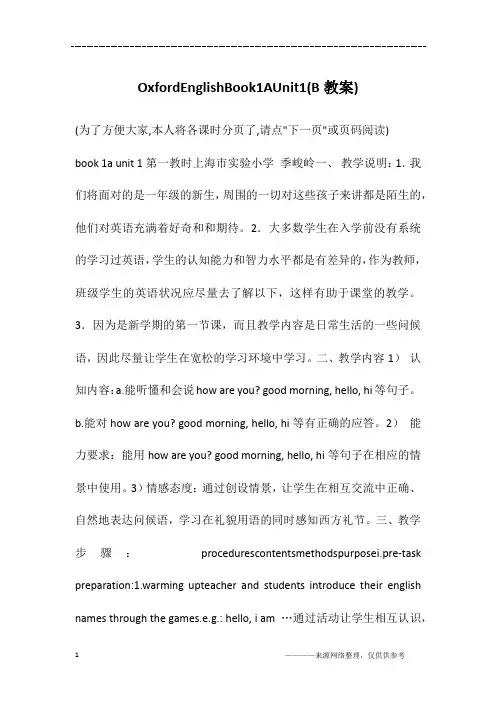
OxfordEnglishBook1AUnit1(B教案)(为了方便大家,本人将各课时分页了,请点"下一页"或页码阅读)book 1a unit 1第一教时上海市实验小学季峻岭一、教学说明:1.我们将面对的是一年级的新生,周围的一切对这些孩子来讲都是陌生的,他们对英语充满着好奇和和期待。
2.大多数学生在入学前没有系统的学习过英语,学生的认知能力和智力水平都是有差异的,作为教师,班级学生的英语状况应尽量去了解以下,这样有助于课堂的教学。
3.因为是新学期的第一节课,而且教学内容是日常生活的一些问候语,因此尽量让学生在宽松的学习环境中学习。
二、教学内容1)认知内容:a.能听懂和会说how are you? good morning, hello, hi等句子。
b.能对how are you? good morning, hello, hi等有正确的应答。
2)能力要求:能用how are you? good morning, hello, hi等句子在相应的情景中使用。
3)情感态度:通过创设情景,让学生在相互交流中正确、自然地表达问候语,学习在礼貌用语的同时感知西方礼节。
三、教学步骤:procedurescontentsmethodspurposei.pre-task preparation:1.warming upteacher and students introduce their english names through the games.e.g.: hello, i am …通过活动让学生相互认识,如果学生没有英语名字,教师可以让学生选择一个自己喜欢的名字。
2.enjoying an english song: students listen to the song , try to understand the meaning by teacher’s presentation.学生在聆听中感知歌曲的旋律和歌词的大意,为进一步学习歌曲做好准备ii.while-task procedure:1.introduction: good morning& how are you? fine, thank you.1.teacher shows a puppet to model the dialogue. e.g.:--hello, kitty. how are you? --fine, thank you. 2.introduce the characters of the book.e.g.: sam, may, ann.教师和布娃娃之间的对话演示给学生,让学生在语境中感知并体验。

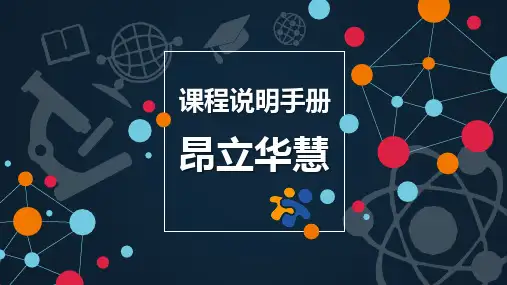
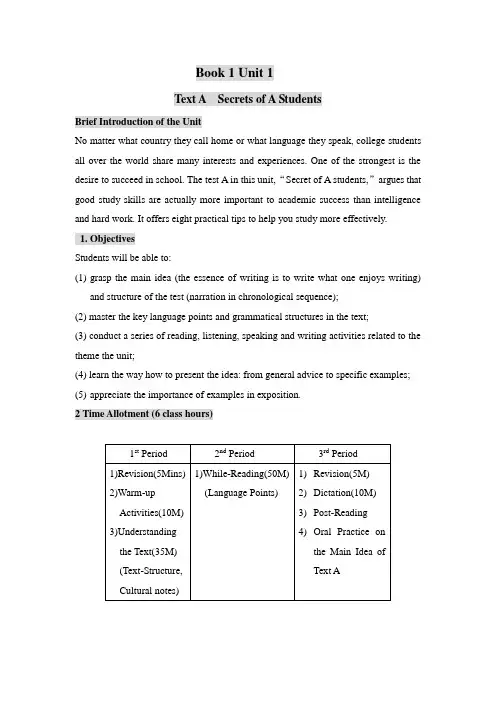
Book 1 Unit 1Text A Secrets of A StudentsBrief Introduction of the UnitNo matter what country they call home or what language they speak, college students all over the world share many interests and experiences. One of the strongest is the desire to succeed in school. The test A in this unit,“Secret of A students,”argues that good study skills are actually more important to academic success than intelligence and hard work. It offers eight practical tips to help you study more effectively.1. ObjectivesStudents will be able to:(1)grasp the main idea (the essence of writing is to write what one enjoys writing)and structure of the test (narration in chronological sequence);(2) master the key language points and grammatical structures in the text;(3) conduct a series of reading, listening, speaking and writing activities related to the theme the unit;(4) learn the way how to present the idea: from general advice to specific examples;(5)appreciate the importance of examples in exposition.2Time Allotment (6 class hours)3 Warm-up Activities(1) Based on the title, guess what the text is about.(2) Arrange the students in group of 4-6, depending on the size of the class; each group elects a chairman, a recorder and a speaker, and introduce the discussion topics;(a) What does your group like or dislike about English?(b) What are the greatest problems your group has in English study?(c)What methods do you think are good in your English study?4Text StructuresThis text is divided into three parts.The first part (1-3paragraph) tells us why A students do well in their study, even if they actually put in fewer hours than their lower-scoring classmates.The second part (4-11) shows us secrets of A students which include eight skills; concentrate, study anywhere, organize your materials, organize your time, learn how to read, take good notes, ask questions, and study together.The third part is to encourage all the students to learn and master the secrets in order to become A students.5 Cultural notes1) grading systemSchool, colleges and universities in Great Britain and the United States commonly use letter grades to indicate the quality of a student’s academic performance: A(excellent), B(good), C(average), D(below average), and F(failing). In the United States, work rated C or above is usually required of an undergraduate student to continue his/herstudies; work rated B or higher is usually required of a graduate student to continue. In percentage scales, 100 percent is the highest mark, and 70 percent (or 65 percent) is usually the lowest passing mark.2) students at universitiesA university student who has not yet taken his or her first, or “bachelor’s” degree is an undergraduate. In the United States, a first-year student at a college or university, and in a high school as well, is called a freshman, a second-year student a sophomore, and a third-year student a junior, and a fourth-year student a senior. A student is a person who has completed a university degree course while a postgraduate (or graduate in the United States) is a person doing studies that are done at a university after one has received a first degree.6 Language Study1) Word-processingA) perform: (vi/t) do (a piece of work, sth one is order to do, sth one has agreed to do) 做,履行,完成; 演出,表演Examples:a)As a top student, she performs extremely well in every lesson.b)State-owned industries more often than not perform poorly.Derivative:a) performance:(n) [sing] process or manner of performing做,履行,完成; 演出,表演·To be faithful in the performance of his duties.Differences: act and performAct: 表示“充当、扮演或演出”,主要指演员在电影、戏剧中扮演角色,主语既可为演员,也可为电影、剧本等。

Unit Two English around the world课程标准中的内容标准:本单元的话题是围绕“世界上的英语”展开的,通过对这一话题的探讨加强学生对英语语言历史和现状的了解,对当代语言特别是英语发展趋势的了解。
教学细目:1、(情感目标)通过阅读,从历史及现状了解“英语世界”,理解英语种种。
BBC英语不再是唯一标准。
现在有美国英语、澳洲英语、非洲英语、甚至东南亚英语,将来还有中国英语。
从而提高学生主动学习英语的兴趣,为将来了解世界、和世界交流打开方便之门。
2、(交际)通过听说学习有关命令与请求在间接引语中的运用表达。
3、(词汇)通过阅读、师生互动掌握本单元的教学目的和要求中的词汇。
4、(写作)通过阅读和书面训练,学习并掌握英文海报的写法和用语。
5、(语法)通过书面训练,深入理解和进一步转述命令和要求时运用动词不定式。
学习领域与主题内容及要求目标层次理解掌握运用1.1.1. 话题:World Englishes√1.1.2功能(通过听和说,能在生活中运用下列英语进行交际):The difficulties in different Englishes in communicationUsing the following expressions: Pardon? I beg your pardon?I don’t understand.How do you spell that?Could you say that again please? Could you speak more slowly please? Sorry, I can’t follow you!Could you repeat that please?√人教版必修一UnitTwoEnglisharoundtheworld1.1.3 Understanding vocabulary(理解词汇)(通过听、看、阅读,能理解√下列词汇含义。
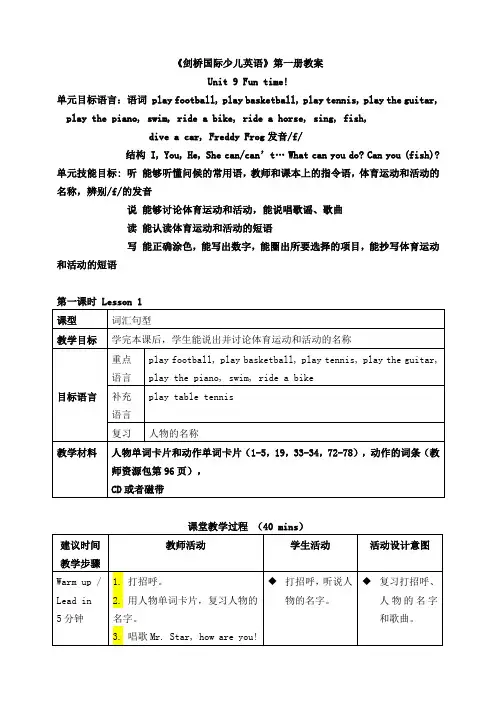
《剑桥国际少儿英语》第一册教案
Unit 9 Fun time!
单元目标语言:语词 play football, play basketball, play tennis, play the guitar, play the piano, swim, ride a bike, ride a horse, sing, fish,
dive a car, Freddy Frog发音/f/
结构 I, You, He, She can/can’t…What can you do? Can you (fish)? 单元技能目标: 听能够听懂问候的常用语,教师和课本上的指令语,体育运动和活动的名称,辨别/f/的发音
说能够讨论体育运动和活动,能说唱歌谣、歌曲
读能认读体育运动和活动的短语
写能正确涂色,能写出数字,能圈出所要选择的项目,能抄写体育运动和活动的短语
第一课时 Lesson 1
课堂教学过程(40 mins)
课堂教学过程(40 mins)
第三课时 Lesson 3
课堂教学过程(40 mins)
第四课时 Lesson 4
第五课时 Lesson 5
课堂教学过程(40 mins)
第六课时 Lesson 6
课堂教学过程(40 mins)。
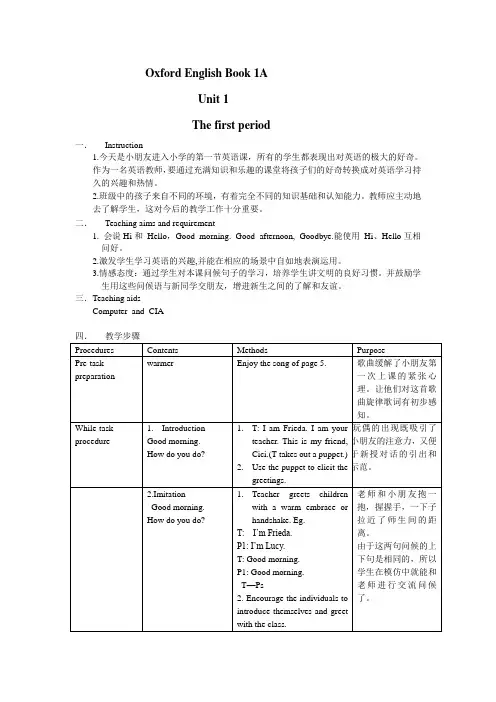
Oxford English Book 1AUnit 1The first period一.Instruction1.今天是小朋友进入小学的第一节英语课,所有的学生都表现出对英语的极大的好奇。
作为一名英语教师,要通过充满知识和乐趣的课堂将孩子们的好奇转换成对英语学习持久的兴趣和热情。
2.班级中的孩子来自不同的环境,有着完全不同的知识基础和认知能力。
教师应主动地去了解学生,这对今后的教学工作十分重要。
二.Teaching aims and requirement1. 会说Hi和Hello,Good morning. Good afternoon, Goodbye.能使用Hi、Hello互相问好。
2.激发学生学习英语的兴趣,并能在相应的场景中自如地表演运用。
3.情感态度:通过学生对本课问候句子的学习,培养学生讲文明的良好习惯。
并鼓励学生用这些问候语与新同学交朋友,增进新生之间的了解和友谊。
三.Teaching aidsComputer and CIA四.教学步骤五.教学提示1.媒体准备:玩偶、响板、歌曲磁带2.教学关注点:本课中的句子例如:Good afternoon. 对于一些从来没有接触过英语的小朋友来说比较困难,为了解决这一问题,可从以下方面做努力。
1)注重学习的过程,为学生的学习铺好台阶;2)在小朋友们喜欢的游戏、歌曲等活动中巩固句子;3)多创设学生间的合作交流的机会,以缓解因差异造成的成效不一。
3.资源分享:九年义务教学课本3A有配套的歌曲:如<Hello, how are you?>4. 设计思路:1)这个单元中的歌曲对于一年级的小朋友而言学起来比较困难。
而少量多次是分解难题的有效方法,因此可将这首歌的学习安排在本单元中的各课时中,让小朋友在几节课中,从感知到熟悉和学唱一步步的学习,这样学起来既轻松又有成效。
3)由于Let‟s talk的内容适合刚入学的一年级新生,所以将这部分内容提前到第一课时来上。
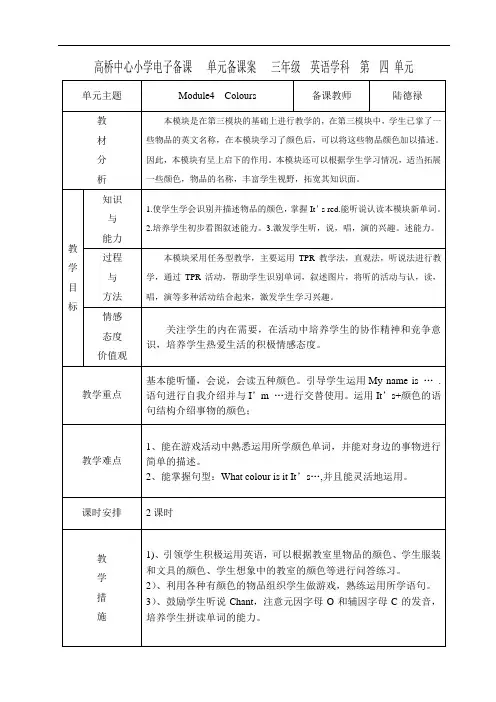
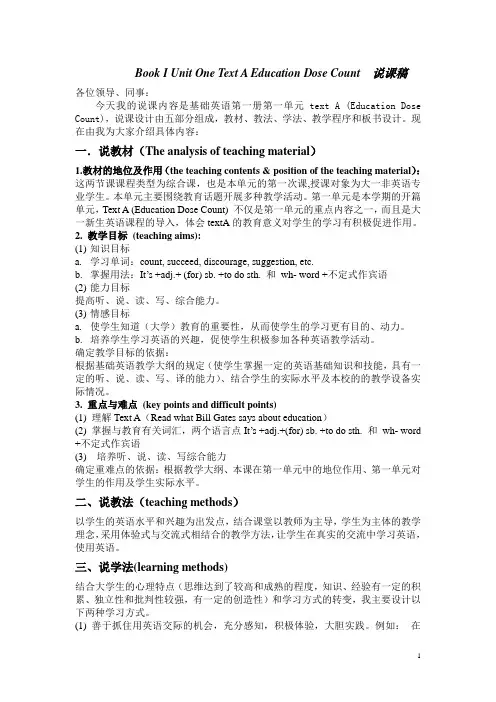
Book I Unit One Text A Education Dose Count 说课稿各位领导、同事:今天我的说课内容是基础英语第一册第一单元text A (Education Dose Count),说课设计由五部分组成,教材、教法、学法、教学程序和板书设计。
现在由我为大家介绍具体内容:一.说教材(The analysis of teaching material)1.教材的地位及作用(the teaching contents & position of the teaching material):这两节课课程类型为综合课,也是本单元的第一次课,授课对象为大一非英语专业学生。
本单元主要围绕教育话题开展多种教学活动。
第一单元是本学期的开篇单元,Text A (Education Dose Count) 不仅是第一单元的重点内容之一,而且是大一新生英语课程的导入,体会textA的教育意义对学生的学习有积极促进作用。
2. 教学目标(teaching aims):(1)知识目标a.学习单词:count, succeed, discourage, suggestion, etc.b.掌握用法:It’s +adj.+ (for) sb. +to do sth. 和wh- word +不定式作宾语(2)能力目标提高听、说、读、写、综合能力。
(3)情感目标a.使学生知道(大学)教育的重要性,从而使学生的学习更有目的、动力。
b.培养学生学习英语的兴趣,促使学生积极参加各种英语教学活动。
确定教学目标的依据:根据基础英语教学大纲的规定(使学生掌握一定的英语基础知识和技能,具有一定的听、说、读、写、译的能力)、结合学生的实际水平及本校的的教学设备实际情况。
3. 重点与难点(key points and difficult points)(1) 理解Text A(Read what Bill Gates says about education)(2) 掌握与教育有关词汇,两个语言点It’s +adj.+(for) sb. +to do sth. 和wh- word +不定式作宾语(3) 培养听、说、读、写综合能力确定重难点的依据:根据教学大纲、本课在第一单元中的地位作用、第一单元对学生的作用及学生实际水平。
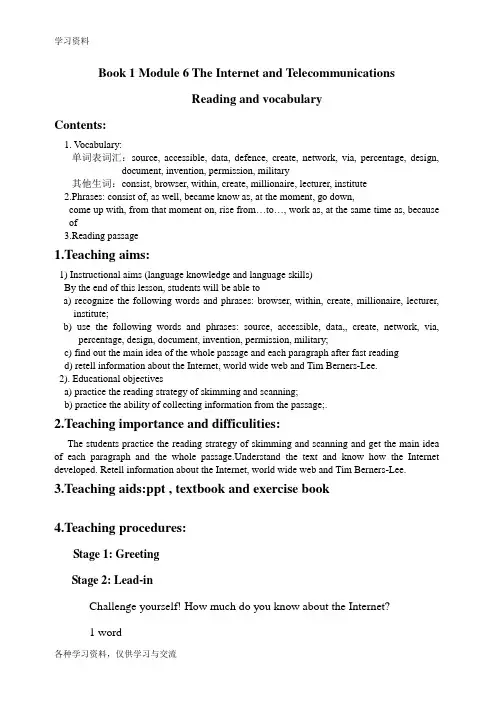
Book 1 Module 6 The Internet and TelecommunicationsReading and vocabularyContents:1. V ocabulary:单词表词汇:source, accessible, data, defence, create, network, via, percentage, design, document, invention, permission, military其他生词:consist, browser, within, create, millionaire, lecturer, institute2.Phrases: consist of, as well, became know as, at the moment, go down,come up with, from that moment on, rise from…to…, work as, at the same time as, because of3.Reading passage1.Teaching aims:1) Instructional aims (language knowledge and language skills)By the end of this lesson, students will be able toa) recognize the following words and phrases: browser, within, create, millionaire, lecturer,institute;b) use the following words and phrases: source, accessible, data,, create, network, via,percentage, design, document, invention, permission, military;c) find out the main idea of the whole passage and each paragraph after fast readingd) retell information about the Internet, world wide web and Tim Berners-Lee.2). Educational objectivesa) practice the reading strategy of skimming and scanning;b) practice the ability of collecting information from the passage;.2.Teaching importance and difficulities:The students practice the reading strategy of skimming and scanning and get the main idea of each paragraph and the whole passage.Understand the text and know how the Internet developed. Retell information about the Internet, world wide web and Tim Berners-Lee.3.Teaching aids:ppt , textbook and exercise book4.Teaching procedures:Stage 1: GreetingStage 2: Lead-inChallenge yourself! How much do you know about the Internet?1 wordwww—the world wide web2 personsBill Gates Microsoft software millionaire billionaireTim Berners-Lee www data3 organizations①DARPA Defense Advanced Research Projects Agency美国国防部高级研究计划局②NSF National Science Foundation 美国国家科学基金会③MIT Massachusetts Institute of Technology麻省理工学院Stage 3: Fast-readingStep 1: Read and find the main idea of the whole passage.What is the passage mainly about?A. The history and the development of InternetB. How to use World Wide WebC. Berners-Lee developed the InternetD. The Internet creates many millionairesStep 2: Match the main ideas with each paragraph.Tip: Pay attention to the first sentence or the last sentence of the paragraph.Para. 1 a. Who invented the World Wide Web?Para. 2 b. What is the Internet ?Para. 3 c. How did the Internet start?Para. 4 d. The present situation (目前状况)of Berners-Lee.Para. 5 e. The development of WWW.Para. 6 f. What is the World Wide Web?(注:1) 根据学生的情况,也可以不出示选项,让学生自己读后归纳2) 若觉得Step 1难,可以先做Step 2,再根据每段大意看全篇) Stage 4: Intensive readingStep 1: The development of the InternetRead the text carefully and find out what happened during these years: In 1969 ____________________________________________________ In 1984 ____________________________________________________ In 1989 ____________________________________________________ In 1991 ____________________________________________________ In 1996 ____________________________________________________ At the moment _______________________________________________ By 2020 ____________________________________________________ Step 2: T/F questions1.There are millions of pages of information on the Internet.2. The US army were the first people who used an Internet system.3. Universities started using the Internet at the same time as the army.4. The percentage of websites in English is getting smaller.5. Tim Berners-Lee made it possible for scientists to use the Internet.6. Berners-Lee made a lot of money from his invention.Stage 3: Post- readingStep 1: RetellWhat have we learnt?(fill in the blanks according to the whole passage)1. Divide students into three groups. Students in each group areresponsible for one topic. First find out the information from the textand write down some key words. Then practice retelling it.2. Presentation (the teacher can show the clue if students find it difficult)1) the Internetthe biggest _______ of information_________ through a computerconsist of millions of pages of _____first used by the army , then universities ________, now everyone2)www____________ by Tima computer _______allows computer users to ________ information__________ is in English (…by 2020 …)3)Tim Berners-LeeFirst, he __________the idea of the World Wide Web.Second, he ________the first “web browser”, which made it possiblefor everyone to use the Internet.Now he works as a ________ at institute.Step 2: Fill in blanks with important words and phrasesThe Internet is the biggest 1.______ of information in the world. It2.___________millions of pages of data. In 1969, a US defenceorganization 3.______ a network of computers called DARPANET for the US army. In 1984, the US NSF started the NSFNET network, which makes it possible for universities to use the system 4._______. NSFNET is 5.____________ the Internet. In 1989, an English scientist6.______________the idea of the World Wide Web, and in 1991, heinvented it. Then he made it possible for everyone to use the Internet.Everyone in the world can 7._____ the Internet using this World Wide Web . 8.____________________, the web and the Internet grew.9.______________, about 80% of web traffic is in English, but this10.____________ is going down. By 2020, much web traffic could be inChinese.Step 3: Discussion:What do you think the Internet will be like in the future?5.Homework: the students try to recite these new words and phrases and finish their exercise book.。
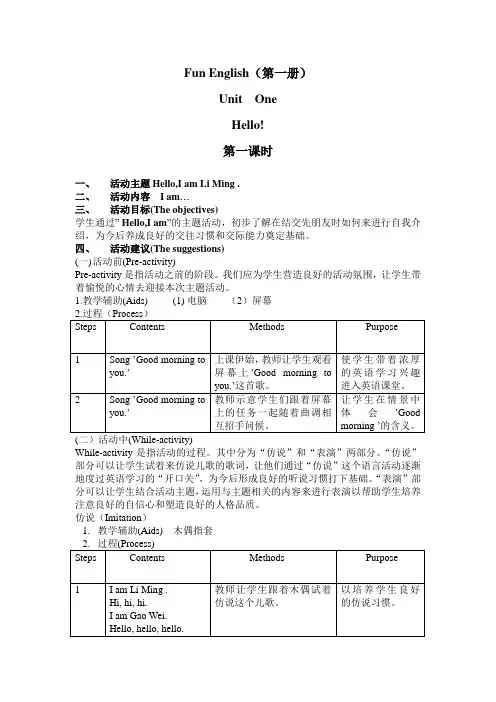
Fun English(第一册)Unit OneHello!第一课时一、活动主题Hello,I am Li Ming .二、活动内容I am…三、活动目标(The objectives)学生通过” Hello,I am”的主题活动,初步了解在结交先朋友时如何来进行自我介绍,为今后养成良好的交往习惯和交际能力奠定基础。
四、活动建议(The suggestions)(一)活动前(Pre-activity)Pre-activity是指活动之前的阶段。
我们应为学生营造良好的活动氛围,让学生带着愉悦的心情去迎接本次主题活动。
1.教学辅助(Aids) (1) 电脑(2)屏幕While-activity是指活动的过程。
其中分为“仿说”和“表演”两部分。
“仿说”部分可以让学生试着来仿说儿歌的歌词,让他们通过“仿说”这个语言活动逐渐地度过英语学习的“开口关”,为今后形成良好的听说习惯打下基础。
“表演”部分可以让学生结合活动主题,运用与主题相关的内容来进行表演以帮助学生培养注意良好的自信心和塑造良好的人格品质。
仿说(Imitation)1.教学辅助(Aids) 木偶指套2 I am Linda.Hi, hi, hi.Hello, Miss Li. 教师让学生分小组进行问候语和自我介绍的练习,训练口语。
增加合作学习的机会,以促进学生相互之间的了解。
表演(Performance)1.教学辅助(Aids) 教学视频,木偶对话。
2.过程(Process)Steps Contents Methods Purpose1 I am Li MingHi, hi, hi.I am LindaHello, hello, hello. 教师播放下载的视频课件,因为学生主要是儿童,对于动画片没有抵抗力,消除他们的恐惧心理。
为学生搭建可以展示自己的舞台,帮助他们树立良好的自信心。
2 I am……Hi, hi, hi.I am ……Hello, hello, hello. 教师让学生二个人一组根据自己的真实姓名来编儿歌,并请学生上台表演。
《剑桥国际少儿英语》第一册教案Unit 9 Fun time!单元目标语言:语词 play football, play basketball, play tennis, play theguitar, play the piano, swim, ride a bike, ride a horse, sing, fish,dive a car, Freddy Frog 发音/f/结构 I, You, He, She can/can’t… What can you do? Can you(fish)?单元技能目标: 听 能够听懂问候的常用语,教师和课本上的指令语,体育运动和活动的名称,辨别/f/的发音说 能够讨论体育运动和活动,能说唱歌谣、歌曲读 能认读体育运动和活动的短语写 能正确涂色,能写出数字,能圈出所要选择的项目,能抄写体育运动和活动的短语第一课时 Lesson 1课型词汇句型教学目标学完本课后,学生能说出并讨论体育运动和活动的名称重点语言play football, play basketball, play tennis, play theguitar, play the piano, swim, ride a bike补充语言play table tennis目标语言复习人物的名称教学材料人物单词卡片和动作单词卡片(1-5,19,33-34,72-78),动作的词条(教师资源包第96页),CD或者磁带课堂教学过程 (40 mins )Read and match.说:Look at Activity 2. 用示例检查学生是否知道要怎么做。
说:Read and match the others. 学生独立完成,然后两人一组核对答案。
学生进行活动时,教师给予帮助。
用单词此词条核对答案。
按活动用书的顺序指着卡片提问,如:Number 3? 学生回答:Ride a bike.Assignment2分钟听三遍CD2,44,边听边指,听三遍CD2,45,边听边跟读/指读单词,请家长签字。
中文名______________Name_______________ Unit 4本课教学内容Class: 朗文英语班Teacher: Bill Date: Friday 第11次语言技能听:听懂服装类词汇说:会说自己和别人的着装唱:复习儿歌《Are these blue pants》读:P34. 5 《Look. Listen. Say》语言知识关键词: these(这些)are ,this(这个),is, she,her(她的)he,his (他的)i,my(我的),clothes, dress, hat, jacket, pants, shirt, shoes, skirt,sock, sweater句型:What are you wearing today? A shirt and pants.语法:第三人称单、复数形式。
What is she wearing today?What are they wearing today?What are you wearing todayHomework 家庭作业背诵单词:shirt ,sock,sweater,pants 各写两行。
听录音:书上P 34, P35完成下面问题!填空:Are ,Is,this, these1. these blue pants? No, they’re not.2. Is a yellow sock? Yes, It’ is.3. Are green pants? No, they’re not.4. this a red skirt? Yes, It is.5. - What are you today?-I’m wearing , and .6.Look at Bill, ______ is wearing a T-shirt. His T-shirt is __________.7.That`s my mother,_______is wearing a skirt and sweater. Her skirt is ______.。
仁爱版九年级英语课程说明书(5篇范例)第一篇:仁爱版九年级英语课程说明书仁爱版九年级英语课程说明书钱家中学:刘金军◆课程名称:中学英语◆课程类型:基础型课程◆教学材料:北京仁爱教育研究所◆授课时间:80课时左右◆授课对象:九年级学生把握教材是教师永远的基本功,对于教材,我们只有悉心研读,方能轻松驾驭。
今天我就从总体目标、本册英语的基本能力要求、教材的编写意图、体例安排、教材的内容和结构、教材的结构与特点、教学建议和策略几个方面对仁爱版九年级英语上册教材的简单说明:一、总体目标随着英语课程改革的重点从重语法、词汇,轻实际运用能力,转变为从学生兴趣、阅历,认知水平出发,通过体验,实践,参与,合作,交流的方式,以发展学生综合能力、情感态度为目标;把学习过程作为培养学生主动思维、大胆实践的过程,从而形成学生自主学习的方式。
培养学生的综合语言运用能力,就成为了基础教育阶段英语课程的总体目标,这一能力的形成建立在学生语言知识、语言技能、情感态度、学习策略和文化意识等素养整体发展基础上。
课标总体要求一句话为:三个目标、四个任务、五个内容标准。
三个目标:1、培养学生的综合语言运用能力为总体目标;2、培养学生语言技能、语言知识、情感态度、学习策略和文化意识等素质为具体目标;3、促进学生个性发展为根本目标。
四个任务:1、培养学生的学习兴趣2、培养语言综合运用能力3、培养创新能力4、培养跨文化意识。
五个内容标准:语言技能、语言知识、情感态度,学习策略和文化意识。
五个目标由浅入深、由简到繁、循环滚动、螺旋上升。
我们所有的教学活动都是围绕这个总体目标来进行的。
二、本册英语的基本能力要求根据总体目标,新课标对九年级英语上册的基本要求,包括:1、有较明确的英语学习动机和积极主动的学习态度。
2、能听懂教师有关熟悉话题的陈述并参与讨论。
3、能就日常生活的各种话题与他人交换信息并陈述自己的意见。
4、能读懂供7-9年级学习阅读的简单读物和报刊、杂志,克服生词障碍,理解大意。